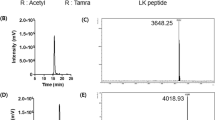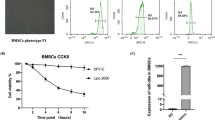Abstract
Regulation of osteogenic differentiation of bone mesenchymal stromal cells (BMSCs) plays a critical role in bone regeneration. As small non-coding RNAs, microRNAs (miRNAs) play an important role in stem cell differentiation through regulating target-mRNA expression. Unfortunately, highly efficient and safe delivery of miRNAs to BMSCs to regulate their osteogenic differentiation remains challenging. Conventional inorganic nanocrystals have shown increased toxicity owing to their larger size precluding renal clearance. Here, we developed novel, surface-engineered, ultra-small gold nanoparticles (USAuNPs, <10 nm) for use as highly efficient miR-5106-delivery systems to enable regulation of BMSC differentiation. We exploited the effects of AuNPs coated layer-by-layer with polyethylenimine (PEI) and liposomes (Lipo) to enhance miR-5106-delivery activity and subsequent BMSC differentiation capacity. The PEI- and Lipo-coated AuNPs (Au@PEI@Lipo) showed negligible cytotoxicity, good miRNA-5106-binding affinity, highly efficient delivery of miRNAs to BMSCs, and long-term miRNA expression (21 days). Additionally, compared with commercial Lipofectamine 3000 and 25 kD PEI, the optimized Au@PEI@Lipo-miR-5106 nanocomplexes significantly enhanced BMSC differentiation into osteoblast-like cells through activation of the Sox9 transcription factor. Our findings reveal a promising strategy for the rational design of ultra-small inorganic nanoparticles as highly efficient miRNA-delivery platforms for tissue regeneration and disease therapy.

Similar content being viewed by others
References
Oliveira, J. M.; Rodrigues, M. T.; Silva, S. S.; Malafaya, P. B.; Gomes, M. E.; Viegas, C. A.; Dias, I. R.; Azevedo, J. T.; Mano, J. F.; Reis, R. L. Novel hydroxyapatite/chitosan bilayered scaffold for osteochondral tissue-engineering applications: Scaffold design and its performance when seeded with goat bone marrow stromal cells. Biomaterials 2006, 27, 6123–6137.
Zhu, Y.; Mao, Z. W.; Gao, C. Y. Control over the gradient differentiation of rat BMSCs on a PCL membrane with surface-immobilized alendronate gradient. Biomacromolecules 2013, 14, 342–349.
Lewis, B. P.; Burge, C. B.; Bartel, D. P. Conserved seed pairing, often flanked by adenosines, indicates that thousands of human genes are microRNA targets. Cell 2005, 120, 15–20.
Stegen, S.; van Gastel, N.; Carmeliet, G. Bringing new life to damaged bone: The importance of angiogenesis in bone repair and regeneration. Bone 2015, 70, 19–27.
Li, Y.; Fan, L. K.; Liu, S. Y.; Liu, W. J.; Zhang, H.; Zhou, T.; Wu, D.; Yang, P.; Shen, L. J.; Chen, J. H. et al. The promotion of bone regeneration through positive regulation of angiogenic–osteogenic coupling using microRNA-26a. Biomaterials 2013, 34, 5048–5058.
Zhang, X. J.; Li, Y.; Chen, Y. E.; Chen, J. H.; Ma, P. X. Cell-free 3D scaffold with two-stage delivery of miRNA-26a to regenerate critical-sized bone defects. Nat. Commun. 2016, 7, 10376.
Kai, Z. S.; Pasquinelli, A. E. MicroRNA assassins: Factors that regulate the disappearance of miRNAs. Nat. Struct. Mol. Biol. 2010, 17, 5–10.
Bozzuto, G.; Molinari, A. Liposomes as nanomedical devices. Int. J. Nanomedicine 2015, 10, 975–999.
Pattni, B. S.; Chupin, V. V.; Torchilin, V. P. New developments in liposomal drug delivery. Chem. Rev. 2015, 115, 10938–10966.
Yin, H.; Kanasty, R. L.; Eltoukhy, A. A.; Vegas, A. J.; Dorkin, J. R.; Anderson, D. G. Non-viral vectors for genebased therapy. Nat. Rev. Genet. 2014, 15, 541–555.
Wang, W.; Li, W.; Ma, N.; Steinhoff, G. Non-viral gene delivery methods. Curr. Pharm. Biotechnol. 2013, 14, 46–60.
Arote, R.; Kim, T.-H.; Kim, Y.-K.; Hwang, S.-K.; Jiang, H.-L.; Song, H.-H.; Nah, J.-W.; Cho, M.-H.; Cho, C.-S. A biodegradable poly(ester amine) based on polycaprolactone and polyethylenimine as a gene carrier. Biomaterials 2007, 28, 735–744.
Xiong, M. P.; Forrest, M. L.; Ton, G.; Zhao, A. N.; Davies, N. M.; Kwon, G. S. Poly(aspartate-g-PEI800), a polyethylenimine analogue of low toxicity and high transfection efficiency for gene delivery. Biomaterials 2007, 28, 4889–4900.
Conde, J.; Edelman, E. R.; Artzi, N. Target-responsive DNA/RNA nanomaterials for microRNA sensing and inhibition: The jack-of-all-trades in cancer nanotheranostics? Adv. Drug Deliv. Rev. 2015, 81, 169–183.
Dong, H. F.; Dai, W. H.; Ju, H. X.; Lu, H. T.; Wang, S. Y.; Xu, L. P.; Zhou, S.-F.; Zhang, Y.; Zhang, X. J. Multifunctional poly(L-lactide)–polyethylene glycol-grafted graphene quantum dots for intracellular microrna imaging and combined specificgene- targeting agents delivery for improved therapeutics. ACS Appl. Mater. Interfaces 2015, 7, 11015–11023.
Wang, X. L.; Lai, Y. X.; Ng, H. H.; Yang, Z. J.; Qin, L. Systemic drug delivery systems for bone tissue regeneration— A mini review. Curr. Pharm. Des. 2015, 21, 1575–1583.
Wang, Y. D.; Zern, B.; Gumera, C. Biomimetic Polymers and Uses Thereof. U.S. Patent 8,529,928, Sep 10, 2013.
Ding, Y.; Jiang, Z. W.; Saha, K.; Kim, C. S.; Kim, S. T.; Landis, R. F.; Rotello, V. M. Gold nanoparticles for nucleic acid delivery. Mol. Ther. 2014, 22, 1075–1083.
Almeida, J. P. M.; Figueroa, E. R.; Drezek, R. A. Gold nanoparticle mediated cancer immunotherapy. Nanomedicine 2014, 10, 503–514.
Austin, L. A.; Mackey, M. A.; Dreaden, E. C.; El-Sayed, M. A. The optical, photothermal, and facile surface chemical properties of gold and silver nanoparticles in biodiagnostics, therapy, and drug delivery. Arch. Toxicol. 2014, 88, 1391–1417.
Ghosh, R.; Singh, L. C.; Shohet, J. M.; Gunaratne, P. H. A gold nanoparticle platform for the delivery of functional microRNAs into cancer cells. Biomaterials 2013, 34, 807–816.
Wang, H. Y.; Jiang, Y. F.; Peng, H. G.; Chen, Y. Z.; Zhu, P. Z.; Huang, Y. Z. Recent progress in microRNA delivery for cancer therapy by non-viral synthetic vectors. Adv. Drug Deliv. Rev. 2015, 81, 142–160.
Bishop, C. J.; Tzeng, S. Y.; Green, J. J. Degradable polymercoated gold nanoparticles for co-delivery of DNA and siRNA. Acta Biomater. 2015, 11, 393–403.
Longmire, M.; Choyke, P. L.; Kobayashi, H. Clearance properties of nano-sized particles and molecules as imaging agents: Considerations and caveats. Nanomedicine 2008, 3, 703–717.
Wang, B.; He, X.; Zhang, Z. Y.; Zhao, Y. L.; Feng, W. Y. Metabolism of nanomaterials in vivo: Blood circulation and organ clearance. Acc. Chem. Res. 2013, 46, 761–769.
Karmali, P. P.; Simberg, D. Interactions of nanoparticles with plasma proteins: Implication on clearance and toxicity of drug delivery systems. Expert Opin. Drug Deliv. 2011, 8, 343–357.
Zhang, X.-D.; Wu, D.; Shen, X.; Liu, P.-X.; Yang, N.; Zhao, B.; Zhang, H.; Sun, Y.-M.; Zhang, L.-A.; Fan, F.-Y. Sizedependent in vivo toxicity of PEG-coated gold nanoparticles. Int. J. Nanomedicine 2011, 6, 2071–2081.
Zhang, X.-D.; Wu, D.; Shen, X.; Liu, P.-X.; Fan, F.-Y.; Fan, S.-J. In vivo renal clearance, biodistribution, toxicity of gold nanoclusters. Biomaterials 2012, 33, 4628–4638.
Dreaden, E. C.; Morton, S. W.; Shopsowitz, K. E.; Choi, J.-H.; Deng, Z. J.; Cho, N.-J.; Hammond, P. T. Bimodal tumor-targeting from microenvironment responsive hyaluronan layer-by-layer (LbL) nanoparticles. ACS Nano 2014, 8, 8374–8382.
Sun, Q.; Kang, Z. S.; Xue, L. J.; Shang, Y. K.; Su, Z. G.; Sun, H. B.; Ping, Q. N.; Mo, R.; Zhang, C. A collaborative assembly strategy for tumor-targeted siRNA delivery. J. Am. Chem. Soc. 2015, 137, 6000–6010.
Gao, C. B.; Vuong, J.; Zhang, Q.; Liu, Y. D.; Yin, Y. D. One-step seeded growth of Au nanoparticles with widely tunable sizes. Nanoscale 2012, 4, 2875–2878.
Link, S.; El-Sayed, M.-A. Size and temperature dependence of the plasmon absorption of colloidal gold nanoparticles. J. Phys. Chem. B 1999, 103, 4212–4217.
Lee, Y.; Lee, S.-H.; Kim, J.-S.; Maruyama, A.; Chen, X. S.; Park, T.-G. Controlled synthesis of PEI-coated gold nanoparticles using reductive catechol chemistry for siRNA delivery. J. Control. Release 2011, 155, 3–10.
Elbakry, A.; Zaky, A.; Liebl, R.; Rachel, R.; Goepferich, A.; Breunig, M. Layer-by-layer assembled gold nanoparticles for siRNA delivery. Nano Lett. 2009, 9, 2059–2064.
Fontana, L.; Pelosi, E.; Greco, P.; Racanicchi, S.; Testa, U.; Liuzzi, F.; Croce, C. M.; Brunetti, E.; Grignani, F.; Peschle, C. MicroRNAs 17–5p-20a-106a control monocytopoiesis through AML1 targeting and M-CSF receptor upregulation. Nat. Cell Biol. 2007, 9, 775–787.
Huang, X.; Gschweng, E.; Van Handel, B.; Cheng, D.; Mikkola, H. K.; Witte, O. N. Regulated expression of microRNAs-126/126* inhibits erythropoiesis from human embryonic stem cells. Blood 2011, 117, 2157–2165.
Boanini, E.; Torricelli, P.; Gazzano, M.; Della Bella, E.; Fini, M.; Bigi, A. Combined effect of strontium and zoledronate on hydroxyapatite structure and bone cell responses. Biomaterials 2014, 35, 5619–5626.
Ehlerding, E. B.; Chen, F.; Cai, W. B. Biodegradable and renal clearable inorganic nanoparticles. Adv. Sci. 2016, 3, 1500223.
Choi, H. S.; Liu, W. B.; Misra, P.; Tanaka, E.; Zimmer, J. P.; Itty Ipe, B.; Bawendi, M. G.; Frangioni, J. V. Renal clearance of quantum dots. Nat. Biotechnol. 2007, 25, 1165–1170.
Yu, M. X.; Zheng, J. Clearance pathways and tumor targeting of imaging nanoparticles. ACS Nano 2015, 9, 6655–6674.
Rana, S.; Bajaj, A.; Mout, R.; Rotello, V. M. Monolayer coated gold nanoparticles for delivery applications. Adv. Drug Deliv. Rev. 2012, 64, 200–216.
Tian, H. Y.; Guo, Z. P.; Chen, J.; Lin, L.; Xia, J. J.; Dong, X.; Chen, X. S. PEI conjugated gold nanoparticles: Efficient gene carriers with visible fluorescence. Adv. Healthc. Mater. 2012, 1, 337–341.
Shen, J. L.; Kim, H. C.; Mu, C. F.; Gentile, E.; Mai, J. H.; Wolfram, J.; Ji, L. N.; Ferrari, M.; Mao, Z. W.; Shen, H. F. Multifunctional gold nanorods for siRNA gene silencing and photothermal therapy. Adv. Healthc. Mater. 2014, 3, 1629–1637.
Valencia-Sanchez, M. A.; Liu, J. D.; Hannon, G. J.; Parker, R. Control of translation and mRNA degradation by miRNAs and siRNAs. Genes Dev. 2006, 20, 515–524.
Peng, B.; Chen, Y. M.; Leong, K. W. MicroRNA delivery for regenerative medicine. Adv. Drug Deliv. Rev. 2015, 88, 108–122.
Yang, J. P.; Zhang, Q.; Chang, H.; Cheng, Y. Y. Surfaceengineered dendrimers in gene delivery. Chem. Rev. 2015, 115, 5274–5300.
Acknowledgments
We acknowledge the valuable comments of potential reviewers. This work was supported by State Key Laboratory for Mechanical Behavior of Materials, the Scientific Research Starting Foundation from Xi’an Jiaotong University (No. DW011798N3000010), the Fundamental Research Funds for the Central Universities (No. XJJ2014090), the Natural Science Basic Research Plan in Shaanxi Province of China (No. 2015JQ5165), and National Natural Science Foundation of China (No. 51502237).
Author information
Authors and Affiliations
Corresponding author
Additional information
These authors contributed equally to this work.
Electronic supplementary material
12274_2016_1265_MOESM1_ESM.pdf
Optimizing surface-engineered ultra-small gold nanoparticles for highly efficient miRNA delivery to enhance osteogenic differentiation of bone mesenchymal stromal cells
Rights and permissions
About this article
Cite this article
Yu, M., Lei, B., Gao, C. et al. Optimizing surface-engineered ultra-small gold nanoparticles for highly efficient miRNA delivery to enhance osteogenic differentiation of bone mesenchymal stromal cells. Nano Res. 10, 49–63 (2017). https://doi.org/10.1007/s12274-016-1265-9
Received:
Revised:
Accepted:
Published:
Issue Date:
DOI: https://doi.org/10.1007/s12274-016-1265-9




